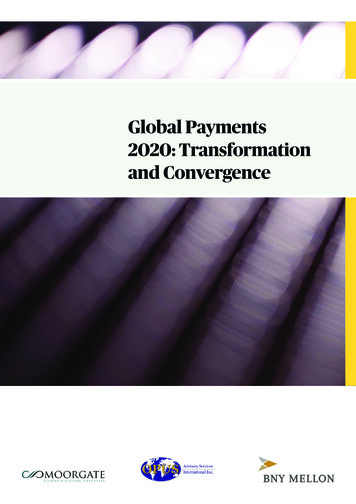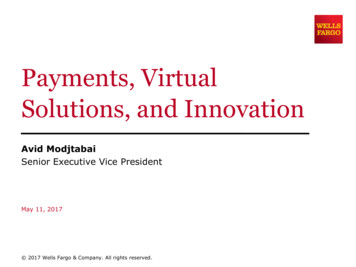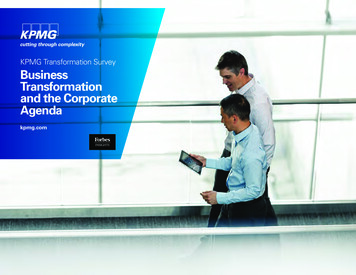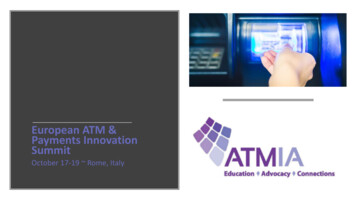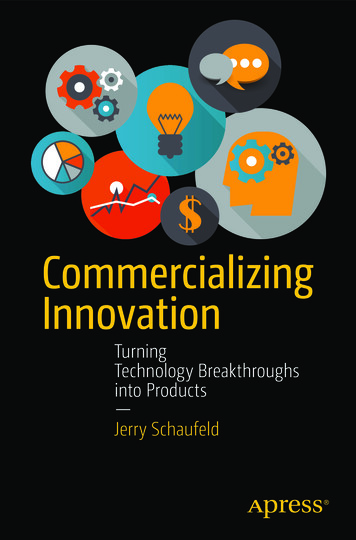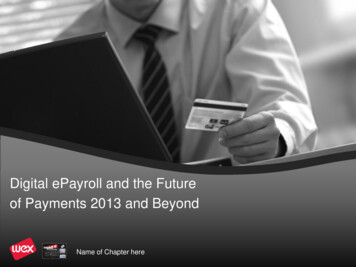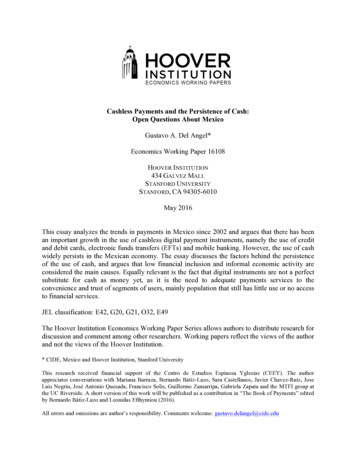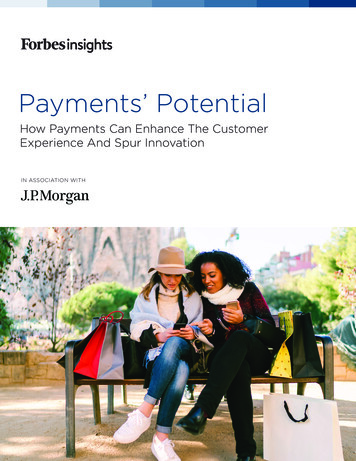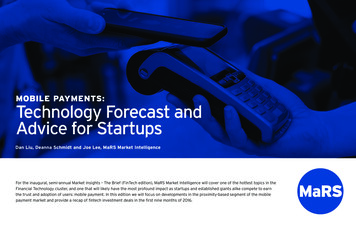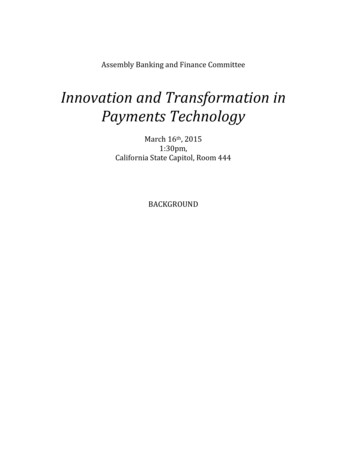
Transcription
Assembly Banking and Finance CommitteeInnovation and Transformation inPayments TechnologyMarch 16th, 20151:30pm,California State Capitol, Room 444BACKGROUND
OverviewThe U.S. remains the last developed country reliant on magnetic stripe credit cards (magstripe), a four-decade old technology. The U.S. is currently on pace to be a full decadebehind Europe on the implementation of credit card chip & PIN technology (EMV-Europay,MasterCard, Visa standard). Currently, all face-to-face credit or debit card transactions usea magnetic stripe to read and record account data, and a signature for verification. Underthis system, the customer hands their card to the clerk at the point of sale, who "swipes"the card through a magnetic reader. The merchant transmits to the acquiring bank thecardholder's account number and the amount of the transaction. The acquiring bankforwards this information to the card association network requesting authorization for thetransaction and the card association forwards the authorization request to the issuingbank. The issuing bank responds with its authorization or denial through the network tothe acquiring bank and then to the merchant. Once approved the issuing bank sends theacquiring bank the transaction amount less an interchange fee. This process occurs in amanner of seconds.This system has proved reasonably effective, but has a number of security flaws, includingthe ability to get physical access to the card via the mail or via the use of black market cardreaders that can read and write the magnetic stripe on the cards, allowing cards to beeasily cloned and used without the owner's knowledge. The inherit convenience of magstripe cards is also their inherit weakness.The terminology and process of a credit card transaction:Acquirer- A bank that processes and settles a merchant's credit card transaction with thehelp of a card issuer.Authorization- The first step in processing a credit card. After a merchant swipes the card,the data is submitted to merchant’s bank, called an acquirer, to request authorization forthe sale. The acquirer then routes the request to the card-issuing bank, where it isauthorized or denied, and the merchant is allowed to process the sale.Batching- The second step in processing a credit card. At the end of a day, the merchantreviews all the day’s sales to ensure they were authorized and signed by the cardholder. Itthen transmits all the sales at once, called a batch, to the acquirer to receive payment.Cardholder- The owner of a card that is used to make credit card purchases.Card network- Visa, MasterCard or other networks that act as an intermediary between anacquirer and an issuer to authorize credit card transactions.Clearing- The third step in processing a credit card. After the acquirer receives the batch, itsends it through the card network, where each sale is routed to the appropriate issuingPage 2 of 22
bank. The issuing bank then subtracts its interchange fees, which are shared with the cardnetwork, and transfers the remaining amount through the network back to the acquirer.Discount fee- A processing fee paid by merchants to acquirers to cover the cost ofprocessing credit cards.Funding- The fourth and final step in processing a credit card. After receiving paymentfrom the issuer, minus interchange fees, the acquirer subtracts its discount fee and sendsthe remainder to the merchant. The merchant is now paid for the transaction, and thecardholder is billed.Interchange fee- A charge paid by merchants to a credit card issuer and a card network as afee for accepting credit cards.Issuer- A financial institution, bank, credit union or company that issues or helps issuecards to cardholders.Chart: Overview of Typical Credit Card Transaction1Highlights from the 2013 Federal Reserve Payments Study Detailed Report1Provided by First Data.Page 3 of 22
Credit cards are more prevalent than other general-purpose card types. Of the 776million general purpose cards in force (issued, activated, and not expired) nationally in2012, 334 million were credit cards, 283 million were debit cards, and 159 million wereprepaid cards. Consumers held the majority of general-purpose credit cards - 10 timesthe number held by businesses (305 million and 28 million, respectively). Among general-purpose cards with purchase activity in 2012, consumers preferred debitcards, with an average use of 23 payments per month, compared with an average of 11payments per month for general-purpose credit cards and 10 payments per month forgeneral-purpose prepaid cards. Although the number of ATM cash withdrawals using debit cards and general-purposeprepaid cards dropped slightly, growth in the value of ATM withdrawals continued toexceed inflation over the years. New information on over-the-counter cash withdrawalsshows that while the number of ATM withdrawals (5.8 billion) far exceeded the numberof over-the-counter withdrawals (2.1 billion) in 2012, the average value of over-thecounter withdrawals, at 715, far exceeded the average value of withdrawals at ATMs( 118). In 2012, there were 1 billion ATM cash deposits with an average value of 374,compared with 1.6 billion over-the-counter cash deposits which averaged 1,000. Not surprisingly, businesses, not consumers, are the overwhelming users of wiretransfers. There were 287.5 million wire transfers—including those sent over large-valuefunds transfer systems and those made on the books of depository institutions in 2012,with a value of 1,116.3 trillion. Consumers accounted for just 6 percent of all wiretransfers by number and 0.14 percent by value. Business customers accounted for thesignificant majority of both the number and value of wire transfers. The number of online bill payments reported by major processors, which included thoseinitiated through online banking websites and directly through billers and settled overACH, exceeded 3 billion in 2012. Secure online payments, including methods that allowusers to enter personal identification numbers (PINs) for debit cards into the computeror that redirect users to use an Internet payment account, totaled more than 1.8 billionin 2012. There were more than 250 million mobile payments made using a mobile walletapplication, and at least 205 million person-to-person or money transfer payments.Page 4 of 22
The number of private-label prepaid transportation payments exceeded all otherprepaid card payments combined in 2012: Payments by prepaid transit cards and farfield radio frequency identification (RFID) transponders for auto tolls had reached acombined 9.9 billion payments. Checks continue to be written less frequently - more than 90 percent of the decline intotal checks was due to reductions in checks for 500 or less, and 45 percent was fromreductions in checks for 50 or less. As of 2012, there were 287 million consumer transaction accounts with an averagevalue of 8,001, while 33 million business transaction accounts averaged almost 62,000. Meanwhile, there were almost 280 million consumer credit card accounts andalmost 29 million business accounts. Credit card balances, which included both currentspending and revolving credit, averaged 1,900 for both consumer and businessaccounts.EMV: Chip CardsThe U.S. has over 10 million credit card terminals and 1.2 billion credit cards, with less than2% of cards having chip technology according to the Smart Card Alliance. Annually, creditcard fraud equals 11 billion globally, with the U.S. portion amounting to 4.73 billion.2The Nilson Report, a credit card industry newsletter, points out that the U.S. accounts forjust over a quarter of the global volume of credit card transactions per year, yet accountsfor almost 50% of the fraud worldwide.Credit card chip technology was established in 1994 by Europay International SA. Thischip technology is also called EMV, as it was named after its original developers, Europay,MasterCard and Visa .EMV technology is used today in more than sixty countries outside of the U.S. withworldwide usage at 40% of the total credit cards and 70% of the total terminals based onthe EMV standard.3A cardholder's data is more secure on the chip-embedded card than on a mag stripe card.Chip-embedded cards support superior encryption and authentication as opposed to magstripe card making the data on mag stripe cards easier to obtain via fraudulent means.Chip technology counters the static nature of mag stripe cards by implementing technologythat creates dynamic values for each transaction in the form of a different verification code2Saporito, Bill. "The Little Strip on Your Debit Card is a Massive Achilles's Heel," Time.com. Jan. 23,20143First Data, EMV in the U.S.: Putting It into Perspective for Merchants and Financial ought-leadership/EMV US.pdfPage 5 of 22
for each transaction. EMV cards can be used both online and in face-to-face transactions,both supporting signature and PIN verification with PIN being the dominant method usedin Europe. However, while the EMV cards can complete online transactions, thosetransactions do not have the same level of security as provided by the chip in the face-toface transaction. In the online scenario the consumer still enters their card data tocomplete payment with the addition of a PIN. Currently, several European paymenttechnology companies are working to bring the Chip & PIN protection to onlinetransactions.EMV compatible cards come in three forms. A chip embedded card is inserted into thePoint of Sale (POS) terminal and the consumer enters their PIN or uses a signature tocomplete the transaction. The other way to pay is via contactless cards in which thetransaction occurs when the consumer swipes their card within the appropriate distance ofthe POS terminal that can read the radio frequency identification device (RFID) on the card.The third type of card is a hybrid chip card that allows for both contact and contactlesstransactions.As previously mentioned, the U.S. has lagged behind in the implementation and acceptanceof EMV technology. The first U.S. credit card utilizing EMV was issued by United NationsFederal Credit Union (UNFCU) in October of 2010. The primary reason UNFCU issued thecard was that many of its members reside outside the U.S. and were in need of a globallyaccepted card. Outside of the U.S. mag stripe cards are becoming less accepted. Prior tolast year's large scale data breaches, most large card issuers in the U.S. (Wells Fargo, JPMChase, and U.S. Bancorp) have begun to migrate some of their portfolios over to EMV cards,but in limited quantities and targeted toward higher income card holders or those thatfrequently travel to European countries. Subsequent to last year's data breaches, severalfinancial institutions replaced cardholder's magstripe cards with EMV cards if they wereamongst the millions that had their payment data compromised.On August 9th, 2011 Visa announced an accelerated implementation to EMV technology andestablished October 1, 2015 as the date when card-present counterfeit fraud liability willshift from issuers to merchant acquirers if fraud occurs in a transaction that could havebeen prevented with a chip-enabled payment terminal.4 While the announcement lays apath towards EMV chip card migration, it does not necessarily set a path to chip-and-PIN asVisa will continue to support both signature and PIN cardholder verification methods. Theannouncement specified incentives and deadlines to urge U.S. merchants to accept bothcontact and contactless chip-enabled cards. One merchant incentive includes theelimination of the requirement for annual card network compliance validation if 75% of amerchant's transactions originate from chip-enabled terminals. For the largest merchants,savings from an annual compliance validation would average approximately 225,000 ayear. Some industry analysts conclude that only 60% of U.S. POS terminals will meet thetarget date.4Press Release available at press1142.jspPage 6 of 22
The history of European adoption of EMV also took a different course and was instigatedfor varying reasons, many of those different than the current debate in the U.S. Americanpayments model has been very efficient through the verification of transactions from POSover land line phone lines. In Europe, the inefficient telephone system used for verification,created pressure for card networks to create a secure and localized payment transactionsystem.The impact of EMV in the United Kingdom was a large reduction in payment card fraud of40% since 2000, however the U.K. Payments Administration claims that the failure of theU.S. market to adopt EMV has impacted the U.K. market as counterfeit fraud increasedbecause criminals would copy data from stolen U.K. cards and would in turn use the stolencards in countries with chip and PIN.5Even in Europe where EMV is over a decade ahead of implementation in the U.S. EMV doesnot protect against all threats. EMV does not exist for card not present transactions such asonline transactions or over the phone, and is unable to protect payment data downstreamin the payment process once it has left the POS terminal. Statistics for the U.K. and otherEMV countries demonstrate that criminals follow the path of least resistance as fraudmigrated away from attacking the card present transaction to target transactions such asonline banking, online shopping, mail, and phone orders.6EMV is but one step of a multi-layered approach to payment security. Julie Conroy, a senioranalysts and fraud expert with Aite Group has stated that the attacker's malware in theTarget breach would have penetrated the payment system regardless of what cards wereused by consumers.7 EMV would have prevented the ability of fraudsters to makeduplicate cards via stealing data at the POS terminal, but it is very unclear whether it wouldhave prevented the Target and Neiman Marcus breaches specifically. However, EMV wouldmake it difficult for criminals to use the information acquired from a breach to makefraudulent cards.Obstacles for EMV Implementation:A factor that contributed to the limited role out of EMV in the U.S. is was that fewmerchants accept EMV chip-embedded cards and the transition is both costly for issuersand merchants. Most EMV chip cards issued abroad and in the U.S. also contain a mag stripthus allowing acceptance at all U.S. merchants that accept credit cards. Also, up until therecent headline generating data security lapses, most American consumers were unawareof EMV technology or retailers that had EMV capable POS terminals.567First Data, 7Ibid, 11Why Target's CEO Changed His Mind About EMV. American Banker. January 21, 2014Page 7 of 22
According to a First Data report on the implementation of EMV the estimated total costscould be around 8 billion.8 The costs to financial institutions to issue mag-stripe cardscosts as little as 10 cents each, whereas EMV cards can cost up to 1.30 each.9 Estimates onthe costs vary in terms of production and issuance to the customers, but some estimatesfind that EMV cards could cost, per card, as much as 10- 15 more than existing mag-stripecards.10 The Aite Group estimates that the implementation of EMV cards could cut fraudlosses in half in the U.S. According to the Nilson Report, U.S. Merchants and banks had2012 losses of 11.5 billion due to credit card fraud or about 5 cents on every 100 spentand will rise to over 12 billion by 2015.As mentioned previously, some estimates find that only 60% of businesses will meet theOctober, 2015 EMV deadline. This means that even during initial phases the marketplacewill still have a fair share of mag-stripe cards and EMV capable cards will also still includemag-stripes so that consumers are still able to use their cards at non-EMV compatiblemerchants. The story of the Netherlands adoption of EMV is telling as they began theirtransition to EMV in 2007 with a target completion date of 2010. This allowed magneticstripe cards to stay in the market longer than most other European countries. During thetransition, criminals targeted the remaining magnetic-stripe terminals and in 2011 therewere 555 successful skimming attacks on payment terminals, up from 176 in 2010.11 In atelling example of the potential issues that can occur with a transition to EMV, PayPalPresident David Marcus reported that on a recent trip to the U.K. his EMV enabled card wascompromised.12The European experience demonstrates that fraud shifts to the weakest links in thepayment system during a transition to EMV. In what may be a controversial statement onEMV, a report from the Federal Reserve Bank of Kansas City finds:Fraud for card-present transactions on lost or stolen cards may stay the same or evenpotentially increase. Many countries that use EMV payment cards do not allowcardholder authentication with signatures. Issuers in the United States, however,appear likely to continue to allow signature authorization on EMV debit and creditcard transactions (Heun; Punch). As a result, fraud on lost or stolen cards may notdecline in the United States. Fraud may even rise as fraudsters, unable to commit fraudon counterfeit cards, begin to target payments with relatively weak security, such as8First Data, 13The Economics of Credit Card Security. Washington Post. January 21, 2014.10Data Breaches Renew Fight Over Credit Card Chip Technology. USA Today. January 30, 2014.11Sullivan, Ricard. The U.S. Adoption of Computer-Chip Payment Cards: Implications for PaymentFraud.12PayPal President's Credit Card Hacked for Shopping Spree. USA Today. February 10, 2014.9Page 8 of 22
transactions that allow signature authorization. Fraudsters may put more effort intostealing computer- chip payment cards, knowing that they may be able to commit afew fraudulent transactions using a forged signature before issuers cut off use of thecard.The experience of countries that have adopted computer-chip payment cards showsthat EMV payment cards offer capabilities for strengthening authentication andpreventing fraud. The degree of payoff from adopting the cards only emerges overtime, however, because authentication methods tend to evolve and improve during atransition period. Still, some fraud will migrate to payments with weak authenticationcapacities, and card issuers will need countermeasures to improve authentication.Research and consulting firm Aite Group estimates that U.S. online card fraud will morethan double to 6.6 billion from 3.3 billion between 2015 and 2018.Another factor that will take some time is consumer education. Prior to the recent databreaches most U.S. consumers had not heard of EMV technology as these cards wereavailable to a limited number of consumers that met certain guidelines, such as a frequenttraveler. The implementation of EMV will require consumers to become comfortable witha new way to make purchases via inserting the card into the terminal and providing a PIN,or tapping the card against the contactless reader. One card network reported that only5% of the contactless cards on the market today are ever used for contactless payments.13The experience of mobile payments implementation may also be telling for the transition toEMV. One of the often cited reasons for the initially slow adoption of mobile paymentsusage by consumers is a lack of viewing mobile payments as more convenient than simplyswiping their card.Finally, the form of EMV technology may offer additional points of concern anddisagreement amongst industry participants. The form of EMV offered will be up to eachissuer so that the credit card market in the U.S. will see a mix of Chip & PIN and chip &signature cards. Chip & signature cards offer less protection than those that require a PINbecause should someone (other than the cardholder) get physical access to the card thesignature is easily forged.Estimates are that 70% of cre
of EMV technology. The first U.S. credit card utilizing EMV was issued by United Nations Federal Credit Union (UNFCU) in October of 2010. The primary reason UNFCU issued the card was that many of its members reside outside the U.S. and were in need of a globally accepted card. Outside of the U.S. mag str
